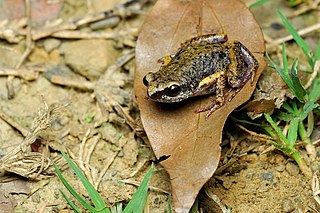
Gastrophryne, the narrowmouth toads, is a genus of microhylid frogs found in the Americas between Honduras and southern United States. Its name means ‘belly-toad’, referring to its large belly, from the Ancient Greek gastēr and phrunē.

Hypopachus is a genus of microhylid frogs found in the Americas between Costa Rica and the southern United States. They can bury themselves under the ground or moss. Its name means ‘somewhat thick’, referring to its tough skin.

The Mexican narrow-mouthed toad is a species of sheep frog native to the Pacific and Caribbean lowlands from southern Texas to Costa Rica. Sheep frogs make a distinctive call that resembles a sheep's bleat during and after rainfall in warm months.
Atelopus pictiventris is a species of toad in the family Bufonidae. It is endemic to Colombia. Its natural habitats are subtropical or tropical moist montane forests, rivers, pastureland, and heavily degraded former forest.
Rhinella humboldti is a species of toad in the family Bufonidae. It is found in Colombia, Venezuela, Trinidad, and the Guianas. This species was originally considered to be a subspecies of Rhinella granulosa.

The evergreen toad is a species of toad in the family Bufonidae.
Nannophryne corynetes, the Abra Malaga toad, is a species of toad in the family Bufonidae that is endemic to Peru and only found in the region of the type locality in the Urubamba Province. Its natural habitats are forest edges restricted to the zone of puna grassland directly adjacent to montane forest. Breeding habitat is unknown but probably aquatic. It is a very rare species but there are no immediate threats to it.

Rhaebo haematiticus is a species of toad in the family Bufonidae. It is found in eastern Honduras, Nicaragua, Costa Rica, Panama, Colombia, northwestern Venezuela, and northwestern Ecuador. Its altitudinal range is from sea level to 1,300 m (4,300 ft) asl. Its natural habitats are primary tropical moist forest and submontane humid forest. It is a nocturnal, leaf-litter species that during the breeding seasons is found along small streams and large rivers. It tolerates some habitat degradation but only occurs close to forest. Threats to it are habitat loss caused by agriculture, wood extraction, and cattle ranching, and locally oil pollution and dams.

Incilius macrocristatus a species of toad in the family Bufonidae. It is found in Chiapas in southern Mexico and the adjacent Guatemala. Its natural habitats are cloud forests and pine-oak-Liquidambar forests. Breeding takes place in streams. It is a rare species that is threatened by habitat loss caused by agriculture and human settlement, and by water pollution.

Incilius melanochlorus, formerly Bufo melanochlorus, is a mid-sized species of toad with a crested head in the family Bufonidae. It is primarily distinguished by its very long first finger with respect to the other fingers. It is found in southern Nicaragua, in the northern Cordillera Central and on the Atlantic slopes of eastern Costa Rica, and in western Panama.

The southwestern toad or Mexican Madre toad is a species of toad in the family Bufonidae. It is endemic to north-western Mexico and found on the Sierra Madre Occidental in eastern Sonora and western Chihuahua and south to south-western Durango. Its natural habitats are conifer forests, commonly along low rivers and streams, its breeding habitat. It is a rare species threatened by habitat disturbance, including alterations causing the desiccation of streams and soils.

Hypopachus ustus, the two-spaded narrow-mouthed toad, is a species of frog in the family Microhylidae found in El Salvador, Guatemala, and Mexico. Its natural habitats are tropical dry and moist lowland forests. Breeding takes place in both temporary and permanent ponds. As this species is widespread and can live modified habitats, it is not considered threatened.
Gastrophrynoides borneensis is a species of frog in the family Microhylidae. It is endemic to Borneo and is known from Sarawak and Sabah in Malaysia, but it is likely to be also found in adjacent Kalimantan (Indonesia). Common name Borneo narrowmouth toad has been coined for it.

Hypopachus barberi is a species of frog in the family Microhylidae. It is found in El Salvador, Guatemala, Honduras, and Mexico. This species is found in humid pine-oak forests at the elevations of 1,470–2,200 m (4,820–7,220 ft) asl. It is threatened by habitat loss due to logging.

The Kalinga narrowmouth toad is a species of frog in the family Microhylidae. It is endemic to the Philippines. Its natural habitats are subtropical or tropical moist lowland forests, subtropical or tropical moist montane forests, arable land, pastureland, and plantations. It is threatened by habitat loss.
The Bicol narrowmouth toad or Catanduanes narrow-mouthed frog is a species of frog in the family Microhylidae. It is endemic to the Philippines, where it is found in the Bicol Peninsula and Catanduanes Island. Its natural habitats are subtropical or tropical moist lowland forests, subtropical or tropical moist montane forests, pastureland, plantations, rural gardens, and heavily degraded former forest. It is threatened by habitat loss.

Kaloula rugifera, the Sichuan digging frog or Szechwan narrowmouth toad, is a species of frog in the family Microhylidae found in China.
Kaloula verrucosa, the verrucous digging frog or Chinese narrowmouth toad, is a species of frog in the family Microhylidae. It is only known from the Yunnan–Guizhou Plateau of southwestern China in Sichuan, Yunnan, and Guizhou provinces, but it is expected to occur in adjacent Myanmar, Laos, and Vietnam. It is a very common species that lives in cultivated fields and in villages. Breeding takes place in temporary pools, ponds, and ditches.

Micryletta steinegeri is a species of frog in the family Microhylidae. It is endemic to central and southern Taiwan. In the past it has also been considered as a synonym of Micryletta inornata from continental Asia.












